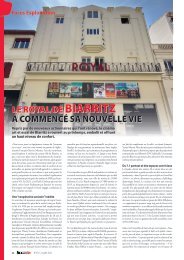Boxoffice-January.07.1950
Create successful ePaper yourself
Turn your PDF publications into a flip-book with our unique Google optimized e-Paper software.
At the left an aerial view of the new fourscreen<br />
type drive-in theatre clearly shows the<br />
arrangement of various elements. In the very<br />
center of the area is the building shown at the<br />
right. This unit, of ultra-modern design,<br />
houses refreshment service facilities and restrooms<br />
on the first floor and employe dressing<br />
rooms and projection booth on the second<br />
floor. On the third floor in a glassed-in space<br />
resembling the control tower of a modern airport<br />
is the manager's office. From this vantage<br />
point he con see every car in the theatre<br />
or holdout area.<br />
Four-Screen Drive-In<br />
Design<br />
Affords Flexible Operation<br />
JJaunched by the novelty of watching moving pictures<br />
under the stars, drive-in theatres made their first great stride<br />
with the advent of the in-car speaker. What is undoubtedly the<br />
greatest milestone since that time is the creation of a four-screen<br />
drive-in theatre arrangement recently put into operation by<br />
Lewis Wilson, west coast drive-in architect and engineer who<br />
has completed pilot installations on the coast and is preparing<br />
to begin construction of thi'ee of his four-screen units in the<br />
St. Louis. Mo., area in the spring.<br />
Basically Wilson's design provides for four small drive-in theatres<br />
with a screen for each in a corner of one large plot and a<br />
common projection booth in the center of the area. By the use<br />
of mirrors, two sets of projectors serve the four screens-<br />
Among the decided advantages of the plan is the flexibility<br />
of operation and the greater economy of construction and operation<br />
it makes possible.<br />
Patrons are closer to the screen where a unit providing for<br />
1,200 autos is divided into separate theatres accommodating<br />
only 300 cars apiece. Costly grading is minimized by the necessity<br />
for no more than six or eight ramps to each theatre. Screen<br />
towers are smaller and less costly to build. With a projection<br />
booth in the center of the project it is possible to employ overhead<br />
wiring instead of costly underground installation required<br />
by the conventional drive-in.<br />
Prom an operational standpoiBt, the fact that the projection<br />
booth-snack bar building is behind all cars means it can be<br />
fully illuminated without interfering with patron's view of the<br />
screen. Located in an island area of approximately one acre,<br />
this building of three stories houses snack bar and restrooms on<br />
the first floor, projection booth and employe dressing rooms<br />
on the second and manager's office on the third floor where he<br />
has an unobstructed view of the entire theatre.<br />
In the surrounding plot it is possible to place a children's<br />
playground where patrons may keep an eye on their small<br />
charges and also watch the picture while enjoying refreshment<br />
from the snack bar.<br />
One of the most important factors of the four-screen arrangement<br />
is the complete control of traffic it affords. By means of<br />
an eight-lane holdout area, provision is made for accommodating<br />
the complete 1,200-car capacity of the theatre. As cars enter<br />
the holdout area they are directed to Lane 1, 2. 3 or 4 and must<br />
stay in that lane to reach their parking spot in the theatre to<br />
which it leads. Once in a lane it is impossible for the patron to<br />
change since they are separated by low fences.<br />
By arranging the showing of films it is possible to have one<br />
break for the entire house, two breaks, or four breaks. This<br />
flexibility means that the traffic emptied into neighboring highways<br />
can be completely controlled. It is estimated by the designers<br />
that the entire theatre can be emptied in twelve minutes<br />
and completely refilled in another fifteen. Not only is the movement<br />
of cars staggered, but peaks of pedestrian traffic within<br />
the area to and from snack bars and restrooms are leveled.<br />
By virtue of construction economies it is estimated this type<br />
of theatre, accommodating 1.200 cars, can be built at one-third<br />
to one-half the cost of a conventional 1.200-car drive-in.<br />
As further testimony to its flexibility, the four-screen type of<br />
drive-in can- be adapted to tracts of many different shapes. It<br />
is also possible to start with a two-screen operation and expand<br />
to the four-screen size as increased business warrants.<br />
BOXOmCE January 7, 1950 43

















